Understanding the Land Surface Phenology and Gross Primary Production of Sugarcane Plantations by Eddy Flux Measurements, MODIS Images, and Data-Driven Models
Abstract
1. Introduction
2. Materials and Methods
2.1. The Description of Study Sites
2.1.1. The Sugarcane Plantation Site in Sao Paulo, Brazil (USR)
2.1.2. The Sugarcane Plantation Site in Louisiana, USA
2.2. Climate and CO2 Flux Data from the Two Sugarcane EC Flux Tower Sites
2.2.1. The Sugarcane Plantation Site in Sao Paulo, Brazil (USR)
2.2.2. The Sugarcane Plantation Site in Louisiana, USA
2.3. MODIS Land Surface Reflectance Data and Calculation of Vegetation Indices during 2000–2018
2.4. NCEP Climate Data
2.5. VPM Model and Simulation
2.5.1. VPM Model
2.5.2. VPM Simulations with the Climate Data from the EC Flux Tower Sites
2.5.3. VPM Simulations with Climate Data from the NCEP Dataset during 2000–2018
2.6. MODIS GPP and NPP Data Product (MOD17)
3. Results
3.1. The Seasonal Dyanmics of Climate, Vegetation Indices, and GPP at the Two Sugarcane Tower Sites
3.2. Estimation of the Site-Specific Optimum Air Tmeperature (Topt) for GPP at the Two Sugarcane Sites
3.3. Seasonal Dynamics of GPP as Simulated by the VPM Model with the Climate Data from the EC Flux Tower Sites (GPPVPM-Site)
3.4. Interannual Variation in GPP as Simulated by the VPM Model with NCEP Climate Data (GPPVPM-NCEP)
4. Discussion
4.1. Biophysical Performance of Vegetation Indices for the Sugarcane Plantations
4.2. A Comparison of GPP Estimates from Multiple Data Products (GPPEC, GPPVPM-Site, GPPVPM-NCEP, GPPMOD17A2, and GPPVPM-Globe)
4.3. Sources of Errors and Uncertainty in Predicted GPPVPM-site at Sugarcane EC Flux Tower Sites
5. Conclusions
Supplementary Materials
Author Contributions
Funding
Acknowledgments
Conflicts of Interest
References
- McCormick, A.J.; Watt, D.A.; Cramer, M.D. Supply and demand: Sink regulation of sugar accumulation in sugarcane. J. Exp. Bot. 2009, 60, 357–364. [Google Scholar] [CrossRef]
- Lakshmanan, P.; Geijskes, R.J.; Aitken, K.S.; Grof, C.L.P.; Bonnett, G.D.; Smith, G.R. Sugarcane biotechnology: The challenges and opportunities. Vitr. Cell. Dev. Biol. Plant 2005, 41, 345–363. [Google Scholar] [CrossRef]
- Dar, R.A.; Dar, E.A.; Kaur, A.; Phutela, U.G. Sweet sorghum-a promising alternative feedstock for biofuel production. Renew. Sustain. Energy Rev. 2018, 82, 4070–4090. [Google Scholar] [CrossRef]
- Chandel, A.K.; da Silva, S.S.; Carvalho, W.; Singh, O.V. Sugarcane bagasse and leaves: Foreseeable biomass of biofuel and bio-products. J. Chem. Technol. Biotechnol. 2012, 87, 11–20. [Google Scholar] [CrossRef]
- Da Silva, F.C.; Diaz-Ambrona, C.G.H.; Buckeridge, M.S.; Souza, A.; Barbieri, V.; Dourado Neto, D. Sugarcane and climate change: Effects of CO2 on potential growth and development. In Proceedings of the IV International Symposium on Applications of Modelling as an Innovative Technology in the Agri-Food-Chain: Model-It, Madrid, Spain, 31 December 2008; pp. 331–336. [Google Scholar]
- Silva-Olaya, A.; Cerri, C.E.P.; La Scala, N., Jr.; Dias, C.T.D.S.; Cerri, C.C. Carbon dioxide emissions under different soil tillage systems in mechanically harvested sugarcane. Environ. Res. Lett. 2013, 8, 015014. [Google Scholar] [CrossRef]
- Galdos, M.V.; Cerri, C.C.; Lal, R.; Bernoux, M.; Feigl, B.; Cerri, C.E.P. Net greenhouse gas fluxes in Brazilian ethanol production systems. Glob. Chang. Biol. Bioenergy 2010, 2, 37–44. [Google Scholar] [CrossRef]
- La Scala, N.; De Figueiredo, E.B.; Panosso, A.R. A review on soil carbon accumulation due to the management change of major Brazilian agricultural activities. Braz. J. Biol. 2012, 72, 775–785. [Google Scholar] [CrossRef]
- Bordonal, R.D.; de Figueiredo, E.B.; La Scala, N. Greenhouse gas balance due to the conversion of sugarcane areas from burned to green harvest, considering other conservationist management practices. GCB Bioenergy 2012, 4, 846–858. [Google Scholar] [CrossRef]
- Chalco Vera, J.; Valeiro, A.; Posse, G.; Moises Acreche, M. To burn or not to burn: The question of straw burning and nitrogen fertilization effect on nitrous oxide emissions in sugarcane. Sci. Total Environ. 2017, 587, 399–406. [Google Scholar] [CrossRef]
- Alkimim, A.; Clarke, K.C. Land use change and the carbon debt for sugarcane ethanol production in Brazil. Land Use Policy 2018, 72, 65–73. [Google Scholar] [CrossRef]
- Egeskog, A.; Freitas, F.; Berndes, G.; Sparouek, G.; Wirsenius, S. Greenhouse gas balances and land use changes associated with the planned expansion (to 2020) of the sugarcane ethanol industry in Sao Paulo, Brazil. Biomass Bioenergy 2014, 63, 280–290. [Google Scholar] [CrossRef]
- Baldocchi, D. Assessing ecosystem carbon balance: Problems and prospects of the eddy covariance technique. Glob. Chang. Biol. 2003, 9, 478–492. [Google Scholar] [CrossRef]
- Running, S.W.; Baldocchi, D.D.; Turner, D.P.; Gower, S.T.; Bakwin, P.S.; Hibbard, K.A. A global terrestrial monitoring network integrating tower fluxes, flask sampling, ecosystem modeling and EOS satellite data. Remote Sens. Environ. 1999, 70, 108–127. [Google Scholar] [CrossRef]
- Fernandez-Martinez, M.; Yu, R.; Gamon, J.; Hmimina, G.; Filella, I.; Balzarolo, M.; Stocker, B.; Penuelas, J. Monitoring Spatial and Temporal Variabilities of Gross Primary Production Using MAIAC MODIS Data. Remote Sens. 2019, 11, 874. [Google Scholar] [CrossRef]
- Runkle, B.R.; Rigby, J.R.; Reba, M.L.; Anapalli, S.S.; Bhattacharjee, J.; Krauss, K.W.; Liang, L.; Locke, M.A.; Novick, K.A.; Sui, R. Delta-flux: An eddy covariance network for a climate-smart lower Mississippi basin. Agric. Environ. Lett. 2017, 2, 1–5. [Google Scholar] [CrossRef]
- Da Rocha, A.E.Q.; de Souza, J.L.; Junior, R.A.F.; Lyra, G.B.; Endres, L.; Lyra, G.B. Water vapour and carbon dioxide fluxes in sugarcane grown in megathermal humid climate in Northeastern Brazil. Aust. J. Crop. Sci. 2018, 12, 755. [Google Scholar] [CrossRef]
- Cabral, O.M.; Rocha, H.R.; Gash, J.H.; Ligo, M.A.; Ramos, N.P.; Packer, A.P.; Batista, E.R. Fluxes of CO2 above a sugarcane plantation in Brazil. Agric. For. Meteorol. 2013, 182, 54–66. [Google Scholar] [CrossRef]
- Pakoktom, T.; Chaichana, N.; Phattaralerphong, J.; Sathornkich, J. Carbon Use Efficiency of the First Ratoon Cane by Eddy Covariance Technique. Int. J. Environ. Sci. Dev. 2013, 4, 488. [Google Scholar] [CrossRef]
- Denmead, O.T.; MacDonald, B.C.T.; White, I.; Griffith, D.W.T.; Bryant, G.; Naylor, T.; Wilson, S.R. Evaporation and carbon dioxide exchange by sugarcane crops. Sugar Cane Int. 2009, 27, 231–236. [Google Scholar]
- Anderson, R.G.; Tirado-Corbala, R.; Wang, D.; Ayars, J.E. Long-rotation sugarcane in Hawaii sustains high carbon accumulation and radiation use efficiency in 2nd year of growth. Agric. Ecosyst. Environ. 2015, 199, 216–224. [Google Scholar] [CrossRef]
- Moon, M.; Zhang, X.Y.; Henebry, G.M.; Liu, L.L.; Gray, J.M.; Melaas, E.K.; Friedl, M.A. Long-term continuity in land surface phenology measurements: A comparative assessment of the MODIS land cover dynamics and VIIRS land surface phenology products. Remote Sens. Environ. 2019, 226, 74–92. [Google Scholar] [CrossRef]
- Piao, S.L.; Liu, Q.; Chen, A.P.; Janssens, I.A.; Fu, Y.S.; Dai, J.H.; Liu, L.L.; Lian, X.; Shen, M.G.; Zhu, X.L. Plant phenology and global climate change: Current progresses and challenges. Glob. Chang. Biol. 2019, 25, 1922–1940. [Google Scholar] [CrossRef] [PubMed]
- Yang, W.; Kobayashi, H.; Wang, C.; Shen, M.G.; Chen, J.; Matsushit, B.; Tang, Y.H.; Kim, Y.; Bret-Harte, M.S.; Zona, D.; et al. A semi-analytical snow-free vegetation index for improving estimation of plant phenology in tundra and grassland ecosystems. Remote Sens. Environ. 2019, 228, 31–44. [Google Scholar] [CrossRef]
- Pillai, N.D.; Nandy, S.; Patel, N.R.; Srinet, R.; Watham, T.; Chauhan, P. Integration of eddy covariance and process-based model for the intra-annual variability of carbon fluxes in an Indian tropical forest. Biodivers. Conserv. 2019, 28, 2123–2141. [Google Scholar] [CrossRef]
- You, Y.F.; Wang, S.Y.; Ma, Y.X.; Wang, X.Y.; Liu, W.H. Improved modeling of gross primary productivity of Alpine Grasslands on the Tibetan Plateau using the biome-BGC model. Remote Sens. 2019, 11, 1287. [Google Scholar] [CrossRef]
- Andrefouet, S.; Payri, C. Scaling-up carbon and carbonate metabolism of coral reefs using in-situ data and remote sensing. Coral Reefs 2001, 19, 259–269. [Google Scholar] [CrossRef]
- Song, T.; Wang, S.Q.; Gao, J.X.; Han, Y.W.; Soc, I.C. A study on the scaling-up of CO2 fluxes at haibei Station based on GIS and RS technologies. In Proceedings of the International Conference on Environmental Science and Information Application Technology, Wuhan, China, 4–5 July 2009; pp. 455–461. [Google Scholar]
- Brogaard, S.; Runnstrom, M.; Seaquist, J.W. Primary production of Inner Mongolia, China, between 1982 and 1999 estimated by a satellite data-driven light use efficiency model. Glob. Planet. Chang. 2005, 45, 313–332. [Google Scholar] [CrossRef]
- Sims, D.A.; Rahman, A.F.; Cordova, V.D.; El-Masri, B.Z.; Baldocchi, D.D.; Flanagan, L.B.; Goldstein, A.H.; Hollinger, D.Y.; Misson, L.; Monson, R.K.; et al. On the use of MODIS EVI to assess gross primary productivity of North American ecosystems. J. Geophys. Res. Biogeosci. 2006, 111. [Google Scholar] [CrossRef]
- Lin, S.; Li, J.; Liu, Q.; Huete, A.; Li, L. Effects of forest canopy vertical stratification on the estimation of gross primary production by remote sensing. Remote Sens. 2018, 10, 1329. [Google Scholar] [CrossRef]
- Madani, N.; Kimball, J.S.; Running, S.W. Improving Global Gross Primary Productivity Estimates by Computing Optimum Light Use Efficiencies Using Flux Tower Data. J. Geophys. Res. Biogeosci. 2017, 122, 2939–2951. [Google Scholar] [CrossRef]
- Shi, Y.; Xu, X.; Du, H.; Zhou, G.; Zhou, Y.; Mao, F.; Li, X.; Zhu, D. Estimation of gross primary production in Moso bamboo forest based on light-use efficiency derived from MODIS reflectance data. Int. J. Remote Sens. 2018, 39, 210–231. [Google Scholar] [CrossRef]
- Zhou, Y.L.; Wu, X.C.; Ju, W.M.; Chen, J.M.; Wang, S.Q.; Wang, H.M.; Yuan, W.P.; Black, T.A.; Jassal, R.; Ibrom, A.; et al. Global parameterization and validation of a two-leaf light use efficiency model for predicting gross primary production across FLUXNET sites. J. Geophys. Res. Biogeosci. 2016, 121, 1045–1072. [Google Scholar] [CrossRef]
- Zhu, H.J.; Lin, A.W.; Wang, L.C.; Xia, Y.; Zou, L. Evaluation of MODIS gross primary production across multiple biomes in China using eddy covariance flux data. Remote Sens. 2016, 8, 395. [Google Scholar] [CrossRef]
- Xiao, X.M.; Hollinger, D.; Aber, J.; Goltz, M.; Davidson, E.A.; Zhang, Q.Y.; Moore, B. Satellite-based modeling of gross primary production in an evergreen needleleaf forest. Remote Sens. Environ. 2004, 89, 519–534. [Google Scholar] [CrossRef]
- Xiao, X.M.; Zhang, Q.Y.; Braswell, B.; Urbanski, S.; Boles, S.; Wofsy, S.; Berrien, M.; Ojima, D. Modeling gross primary production of temperate deciduous broadleaf forest using satellite images and climate data. Remote Sens. Environ. 2004, 91, 256–270. [Google Scholar] [CrossRef]
- Xiao, X.M.; Zhang, Q.Y.; Hollinger, D.; Aber, J.; Moore, B. Modeling gross primary production of an evergreen needleleaf forest using modis and climate data. Ecol. Appl. 2005, 15, 954–969. [Google Scholar] [CrossRef]
- Xiao, X.M.; Zhang, Q.Y.; Saleska, S.; Hutyra, L.; De Camargo, P.; Wofsy, S.; Frolking, S.; Boles, S.; Keller, M.; Moore, B. Satellite-based modeling of gross primary production in a seasonally moist tropical evergreen forest. Remote Sens. Environ. 2005, 94, 105–122. [Google Scholar] [CrossRef]
- Li, Z.Q.; Yu, G.R.; Xiao, X.M.; Li, Y.N.; Zhao, X.Q.; Ren, C.Y.; Zhang, L.M.; Fu, Y.L. Modeling gross primary production of alpine ecosystems in the Tibetan Plateau using MODIS images and climate data. Remote Sens. Environ. 2007, 107, 510–519. [Google Scholar] [CrossRef]
- Wu, W.X.; Wang, S.Q.; Xiao, X.M.; Yu, G.R.; Fu, Y.L.; Hao, Y.B. Modeling gross primary production of a temperate grassland ecosystem in Inner Mongolia, China, using MODIS imagery and climate data. Sci. China Ser. D Earth Sci. 2008, 51, 1501–1512. [Google Scholar] [CrossRef]
- Kalfas, J.L.; Xiao, X.M.; Vanegas, D.X.; Verma, S.B.; Suyker, A.E. Modeling gross primary production of irrigated and rain-fed maize using MODIS imagery and CO2 flux tower data. Agric. For. Meteorol. 2011, 151, 1514–1528. [Google Scholar] [CrossRef]
- Wang, Z.; Xiao, X.; Yan, X. Modeling gross primary production of maize cropland and degraded grassland in northeastern China. Agric. For. Meteorol. 2010, 150, 1160–1167. [Google Scholar] [CrossRef]
- Xin, F.F.; Xiao, X.M.; Zhao, B.; Miyata, A.; Baldocchi, D.; Knox, S.; Kang, M.; Shim, K.M.; Min, S.; Chen, B.Q.; et al. Modeling gross primary production of paddy rice cropland through analyses of data from CO2 eddy flux tower sites and MODIS images. Remote Sens. Environ. 2017, 190, 42–55. [Google Scholar] [CrossRef]
- Kang, X.M.; Wang, Y.F.; Chen, H.; Tian, J.Q.; Cui, X.Y.; Rui, Y.C.; Zhong, L.; Kardol, P.; Hao, Y.B.; Xiao, X.M. Modeling carbon fluxes using multi-temporal MODIS imagery and CO2 eddy flux tower data in Zoige alpine wetland, south-west China. Wetlands 2014, 34, 603–618. [Google Scholar] [CrossRef]
- Kang, X.M.; Yan, L.; Zhang, X.D.; Li, Y.; Tian, D.S.; Peng, C.H.; Wu, H.D.; Wang, J.Z.; Zhong, L. Modeling gross primary production of a typical coastal wetland in China using MODIS time series and CO2 eddy flux tower data. Remote Sens. 2018, 10, 708. [Google Scholar] [CrossRef]
- Singh, D. Generation and evaluation of gross primary productivity using Landsat data through blending with MODIS data. Int. J. Appl. Earth Obs. Geoinf. 2011, 13, 59–69. [Google Scholar] [CrossRef]
- Marin, F.R.; Jones, J.W.; Royce, F.; Suguitani, C.; Donzeli, J.L.; Wander Filho, J.P.; Nassif, D.S. Parameterization and evaluation of predictions of DSSAT/CANEGRO for Brazilian sugarcane. Agron. J. 2011, 103, 304–315. [Google Scholar] [CrossRef]
- Cabral, O.M.; Rocha, H.R.; Gash, J.H.; Ligo, M.A.; Tatsch, J.D.; Freitas, H.C.; Brasilio, E. Water use in a sugarcane plantation. GCB Bioenergy 2012, 4, 555–565. [Google Scholar] [CrossRef]
- White, P.M.; Webber, C.L.; Viator, R.P.; Aita, G. Sugarcane biomass, dry matter, and sucrose availability and variability when grown on a bioenergy feedstock production cycle. BioEnergy Res. 2018, 12, 55–67. [Google Scholar] [CrossRef]
- Reichstein, M.; Tenhunen, J.D.; Roupsard, O.; Ourcival, J.M.; Rambal, S.; Dore, S.; Valentini, R. Ecosystem respiration in two Mediterranean evergreen Holm Oak forests: Drought effects and decomposition dynamics. Funct. Ecol. 2002, 16, 27–39. [Google Scholar] [CrossRef]
- Campos-Taberner, M.; Moreno-Martinez, A.; Garcia-Haro, F.J.; Camps-Valls, G.; Robinson, N.P.; Kattge, J.; Running, S.W. Global estimation of biophysical variables from Google Earth Engine platform. Remote Sens. 2018, 10, 1167. [Google Scholar] [CrossRef]
- Kumar, L.; Mutanga, O. Google Earth Engine applications since inception: Usage, trends, and potential. Remote Sens. 2018, 10, 1509. [Google Scholar] [CrossRef]
- Zhang, Y.; Xiao, X.; Jin, C.; Dong, J.; Zhou, S.; Wagle, P.; Joiner, J.; Guanter, L.; Zhang, Y.; Zhang, G.; et al. Consistency between sun-induced chlorophyll fluorescence and gross primary production of vegetation in North America. Remote Sens. Environ. 2016, 183, 154–169. [Google Scholar] [CrossRef]
- Zhang, Y.; Xiao, X.; Wu, X.; Zhou, S.; Zhang, G.; Qin, Y.; Dong, J. A global moderate resolution dataset of gross primary production of vegetation for 2000–2016. Sci. Data 2017, 4, 170165. [Google Scholar] [CrossRef] [PubMed]
- Zhao, M.; Heinsch, F.A.; Nemani, R.R.; Running, S.W. Improvements of the MODIS terrestrial gross and net primary production global data set. Remote Sens. Environ. 2005, 95, 164–176. [Google Scholar] [CrossRef]
- Jin, C.; Xiao, X.M.; Wagle, P.; Griffis, T.; Dong, J.W.; Wu, C.Y.; Qin, Y.W.; Cook, D.R. Effects of in-situ and reanalysis climate data on estimation of cropland gross primary production using the Vegetation Photosynthesis Model. Agric. For. Meteorol. 2015, 213, 240–250. [Google Scholar] [CrossRef]
- Papaioannou, G.; Papanikolaou, N.; Retalis, D.J.T.A. Relationships of photosynthetically active radiation and shortwave irradiance. Theor. Appl. Climatol. 1993, 48, 23–27. [Google Scholar] [CrossRef]
- Pinker, R.T.; Zhao, M.; Wang, H.; Wood, E.F. Impact of satellite based PAR on estimates of terrestrial net primary productivity. Int. J. Remote Sens. 2010, 31, 5221–5237. [Google Scholar] [CrossRef]
- Tsubo, M.; Walker, S. Relationships between photosynthetically active radiation and clearness index at Bloemfontein, South Africa. Theor. Appl. Climatol. 2005, 80, 17–25. [Google Scholar] [CrossRef]
- McCree, K.J. Test of current definitions of photosynthetically active radiation against leaf photosynthesis data. Agric. Meteorol. 1972, 10, 443–453. [Google Scholar] [CrossRef]
- Xiangming, X. Light absorption by leaf chlorophyll and maximum light use efficiency. IEEE Trans. Geosci. Remote Sens. 2006, 44, 1933–1935. [Google Scholar] [CrossRef]
- Meinzer, F.C.; Zhu, J. Nitrogen stress reduces the efficiency of the C-4 CO2 concentrating system, and therefore quantum yield, in Saccharum (sugarcane) species. J. Exp. Bot. 1998, 49, 1227–1234. [Google Scholar] [CrossRef]
- Raich, J.W.; Rastetter, E.B.; Melillo, J.M.; Kicklighter, D.W.; Steudler, P.A.; Peterson, B.J.; Grace, A.L.; Moore, B.; Vorosmarty, C.J. Potential net primary productivity in South-America-application of a global model. Ecol. Appl. 1991, 1, 399–429. [Google Scholar] [CrossRef]
- Chang, Q.; Xiao, X.; Wu, X.; Doughty, R.; Jiao, W.; Bajgain, R.; Qin, Y.; Wang, J.J.E.R.L. Estimating site-specific optimum air temperature and assessing its effect on the photosynthesis of grasslands in mid-to high-latitudes. Environ. Res. Lett. 2020, 15, 034064. [Google Scholar] [CrossRef]
- Doughty, R.; Xiao, X.; Wu, X.; Zhang, Y.; Bajgain, R.; Zhou, Y.; Qin, Y.; Zou, Z.; McCarthy, H.; Friedman, J. Responses of gross primary production of grasslands and croplands under drought, pluvial, and irrigation conditions during 2010–2016, Oklahoma, USA. Agric. Water Manag. 2018, 204, 47–59. [Google Scholar] [CrossRef]
- Zhou, Y.; Xiao, X.; Zhang, G.; Wagle, P.; Bajgain, R.; Dong, J.; Jin, C.; Basara, J.B.; Anderson, M.C.; Hain, C. Quantifying agricultural drought in tallgrass prairie region in the US Southern Great Plains through analysis of a water-related vegetation index from MODIS images. Agric. For. Meteorol. 2017, 246, 111–122. [Google Scholar] [CrossRef]
- Zhang, Y.; Xiao, X.M.; Zhou, S.; Ciais, P.; McCarthy, H.; Luo, Y.Q. Canopy and physiological controls of GPP during drought and heat wave. Geophys. Res. Lett. 2016, 43, 3325–3333. [Google Scholar] [CrossRef]
- Wagle, P.; Xiao, X.M.; Suyker, A.E. Estimation and analysis of gross primary production of soybean under various management practices and drought conditions. ISPRS J. Photogramm. Remote Sens. 2015, 99, 70–83. [Google Scholar] [CrossRef]
- Mulianga, B.; Bégué, A.; Clouvel, P.; Todoroff, P. Mapping cropping practices of a sugarcane-based cropping system in Kenya using remote sensing. Remote Sens. 2015, 7, 14428–14444. [Google Scholar] [CrossRef]
- Chen, C.; Li, D.; Gao, Z.Q.; Tang, J.W.; Guo, X.F.; Wang, L.L.; Wan, B.C. Seasonal and Interannual Variations of Carbon Exchange over a Rice-Wheat Rotation System on the North China Plain. Adv. Atmospheric Sci. 2015, 32, 1365–1380. [Google Scholar] [CrossRef]
- Xavier, A.C.; Rudorff, B.F.; Shimabukuro, Y.E.; Berka, L.M.S.; Moreira, M.A. Multi-temporal analysis of MODIS data to classify sugarcane crop. Int. J. Remote Sens. 2006, 27, 755–768. [Google Scholar] [CrossRef]
- Rudorff, B.F.T.; Adami, M.; De Aguiar, D.A.; Gusso, A.; Da Silva, W.F.; De Freitas, R.M. Temporal series of EVI/MODIS to identify land converted to sugarcane. In Proceedings of the IEEE International Geoscience and Remote Sensing Symposium, Cape Town, South Africa, 12–17 July 2009; pp. IV-252–IV-255. [Google Scholar]
- Rahman, M.R.; Islam, A.; Rahman, M.A.J.P.P. NDVI derived sugarcane area identification and crop condition assessment. Plan Plus 2004, 1, 1–12. [Google Scholar]
- Mulianga, B.; Bégué, A.; Simoes, M.; Todoroff, P. Forecasting regional sugarcane yield based on time integral and spatial aggregation of MODIS NDVI. Remote Sens. 2013, 5, 2184–2199. [Google Scholar] [CrossRef]
- Abdel-Rahman, E.; Ahmed, F. The application of remote sensing techniques to sugarcane (Saccharum spp. hybrid) production: A review of the literature. Int. J. Remote Sens. 2008, 29, 3753–3767. [Google Scholar] [CrossRef]
- Zhou, Z.; Huang, J.; Wang, J.; Zhang, K.; Kuang, Z.; Zhong, S.; Song, X. Object-oriented classification of sugarcane using time-series middle-resolution Remote Sensing data based on adaboost. PLoS ONE 2015, 10, e0142069. [Google Scholar] [CrossRef]
- White, P.M.; Viator, R.P.; Webber, C.L.; Eggleston, G. Potential losses of Soil nutrients and energy content on the complete removal of sugarcane leaf material as a biomass feedstock. Sugar Tech 2018, 20, 40–49. [Google Scholar] [CrossRef]
- Yan, H.; Fu, Y.L.; Xiao, X.; Huang, H.Q.; He, H.; Ediger, L. Modeling gross primary productivity for winter wheat-maize double cropping System using MODIS time series and CO2 eddy flux tower data. Agric. Ecosyst. Environ. 2009, 129, 391–400. [Google Scholar] [CrossRef]
- He, M.Z.; Zhou, Y.L.; Ju, W.M.; Chen, J.M.; Zhang, L.; Wang, S.Q.; Saigusa, N.; Hirata, R.; Murayama, S.; Liu, Y.B. Evaluation and improvement of MODIS gross primary productivity in typical forest ecosystems of East Asia based on eddy covariance measurements. J. For. Res. 2013, 18, 31–40. [Google Scholar] [CrossRef]
- Sims, D.; Rahman, A.; Cordova, V.; Elmasri, B.; Baldocchi, D.; Bolstad, P.; Flanagan, L.; Goldstein, A.; Hollinger, D.; Misson, L. A new model of gross primary productivity for North American ecosystems based solely on the enhanced vegetation index and land surface temperature from MODIS. Remote Sens. Environ. 2008, 112, 1633–1646. [Google Scholar] [CrossRef]
- Sjöström, M.; Zhao, M.; Archibald, S.; Arneth, A.; Cappelaere, B.; Falk, U.; de Grandcourt, A.; Hanan, N.; Kergoat, L.; Kutsch, W.; et al. Evaluation of MODIS gross primary productivity for Africa using eddy covariance data. Remote Sens. Environ. 2013, 131, 275–286. [Google Scholar] [CrossRef]
- Zhao, M.; Running, S.W.; Nemani, R.R. Sensitivity of Moderate Resolution Imaging Spectroradiometer (MODIS) terrestrial primary production to the accuracy of meteorological reanalyses. J. Geophys. Res. Biogeosci. 2006, 111. [Google Scholar] [CrossRef]
- Ehleringer, J.R.; Sage, R.F.; Flanagan, L.B.; Pearcy, R.W. Climate change and the evolution of C4 photosynthesis. Trends Ecol. Evol. 1991, 6, 95–99. [Google Scholar] [CrossRef]
- Xiao, J.F.; Davis, K.J.; Urban, N.M.; Keller, K.; Saliendra, N.Z. Upscaling carbon fluxes from towers to the regional scale: Influence of parameter variability and land cover representation on regional flux estimates. J. Geophys. Res. Biogeosci. 2011, 116, 15. [Google Scholar] [CrossRef]
- Sanchez, M.L.; Pardo, N.; Perez, I.A.; Garcia, M.A. GPP and maximum light use efficiency estimates using different approaches over a rotating biodiesel crop. Agric. For. Meteorol. 2015, 214, 444–455. [Google Scholar] [CrossRef]
- De Silva, A.; De Costa, W. Growth and radiation use efficiency of sugarcane under irrigated and rain-fed conditions in Sri Lanka. Sugar Tech 2012, 14, 247–254. [Google Scholar] [CrossRef]
- Robertson, M.; Wood, A.; Muchow, R. Growth of sugarcane under high input conditions in tropical Australia. I. Radiation use, biomass accumulation and partitioning. Field Crops Res. 1996, 48, 11–25. [Google Scholar] [CrossRef]
- Muchow, R.C.; Evensen, C.I.; Osgood, R.V.; Robertson, M.J. Yield accumulation in irrigated sugarcane: II. Utilization of intercepted radiation. Agron. J. 1997, 89, 646–652. [Google Scholar] [CrossRef]
- Schwerz, F.; Medeiros, S.L.P.; Elli, E.F.; Eloy, E.; Sgarbossa, J.; Caron, B.O. Plant growth, radiation use efficiency and yield of sugarcane cultivated in agroforestry systems: An alternative for threatened ecosystems. Anais da Academia Brasileira de Ciências 2018, 90, 3265–3283. [Google Scholar] [CrossRef]

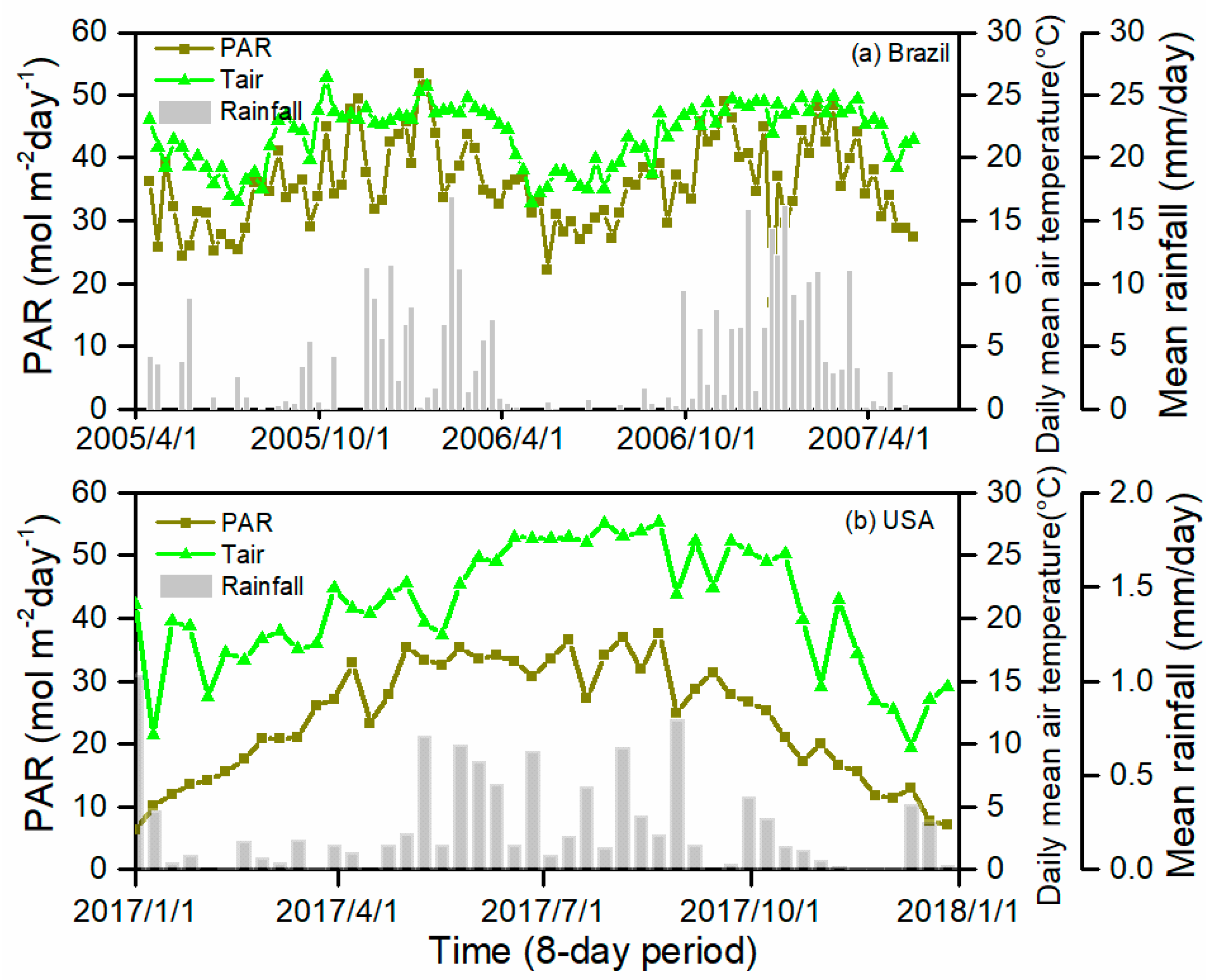
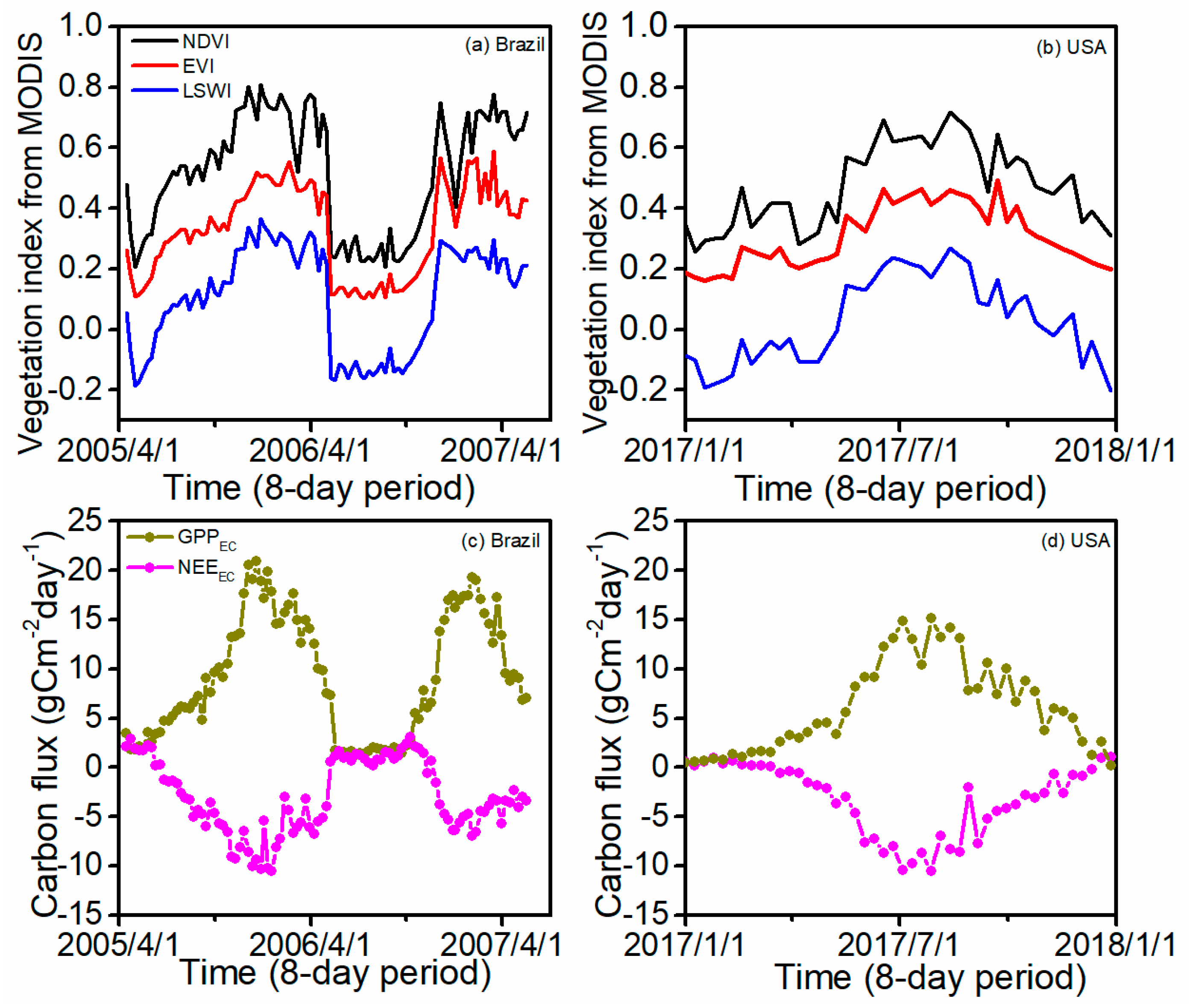
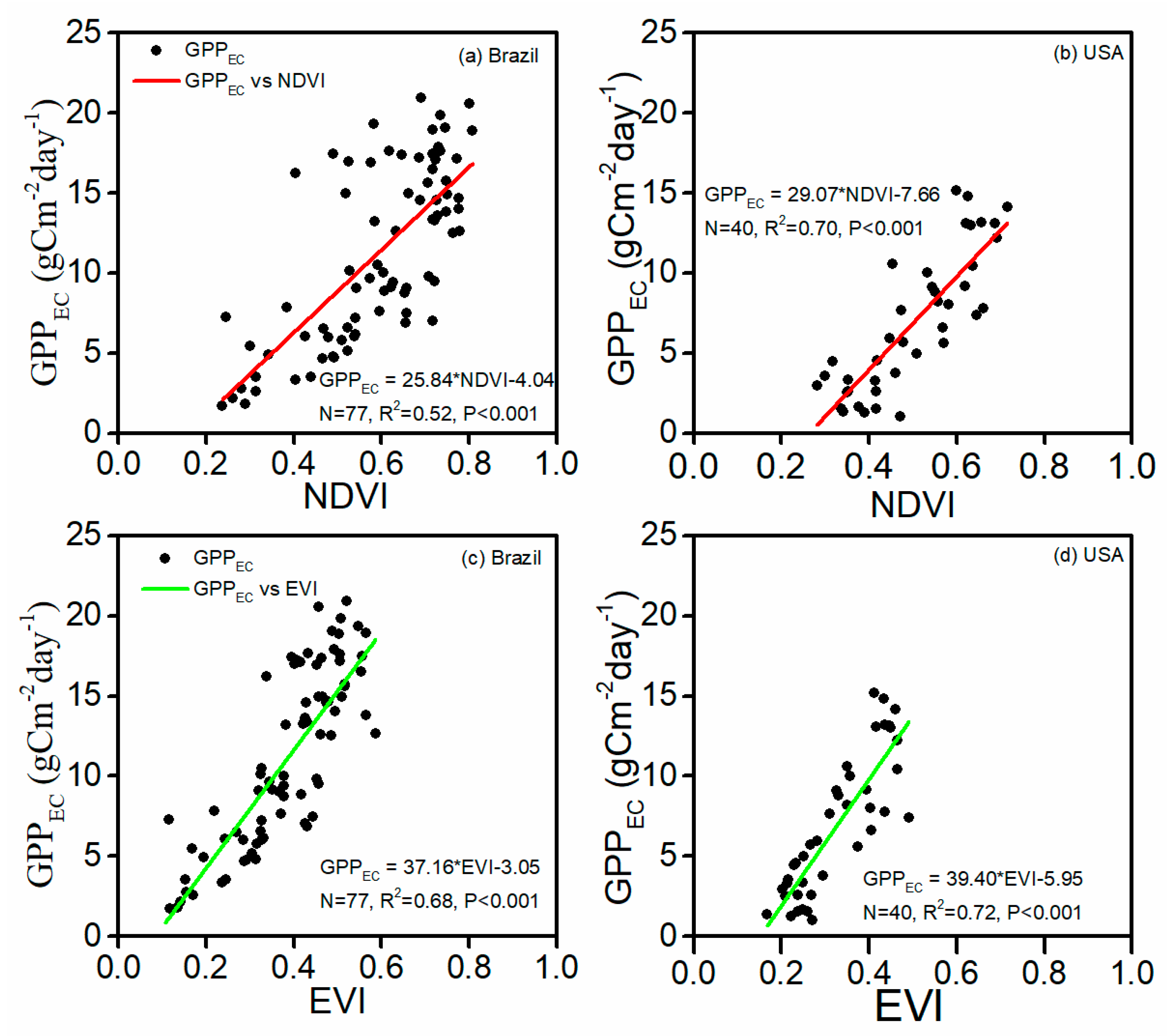

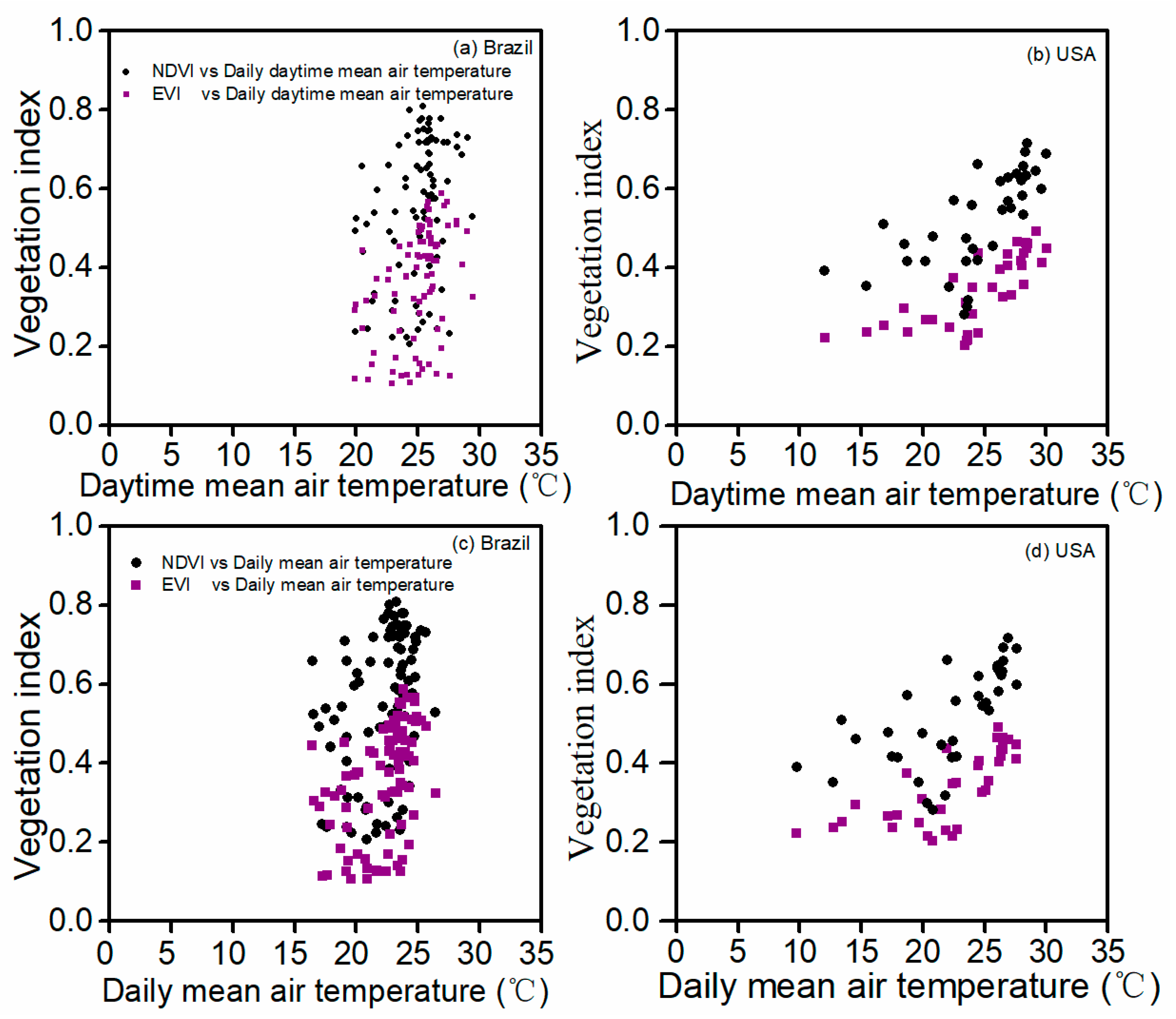


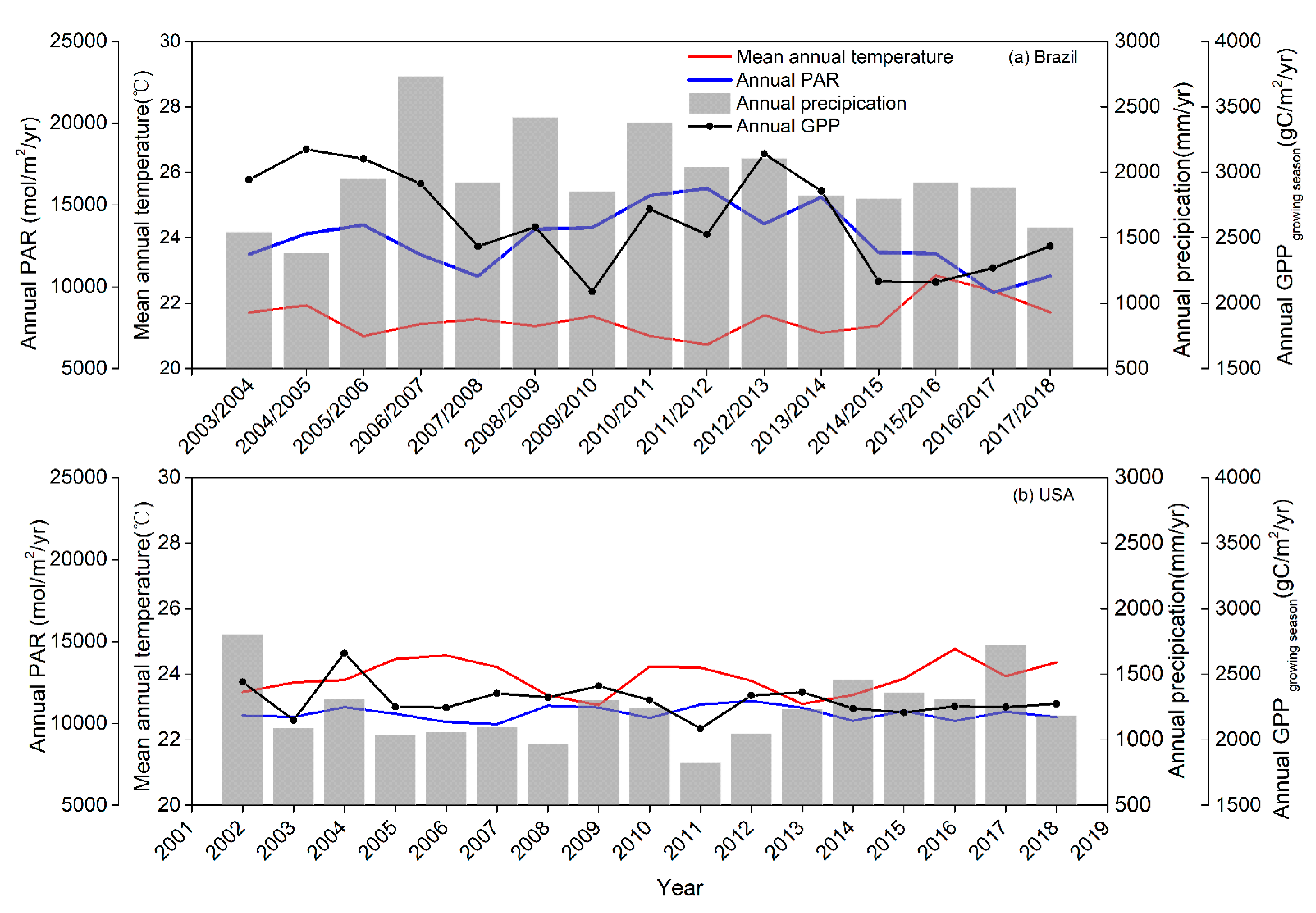
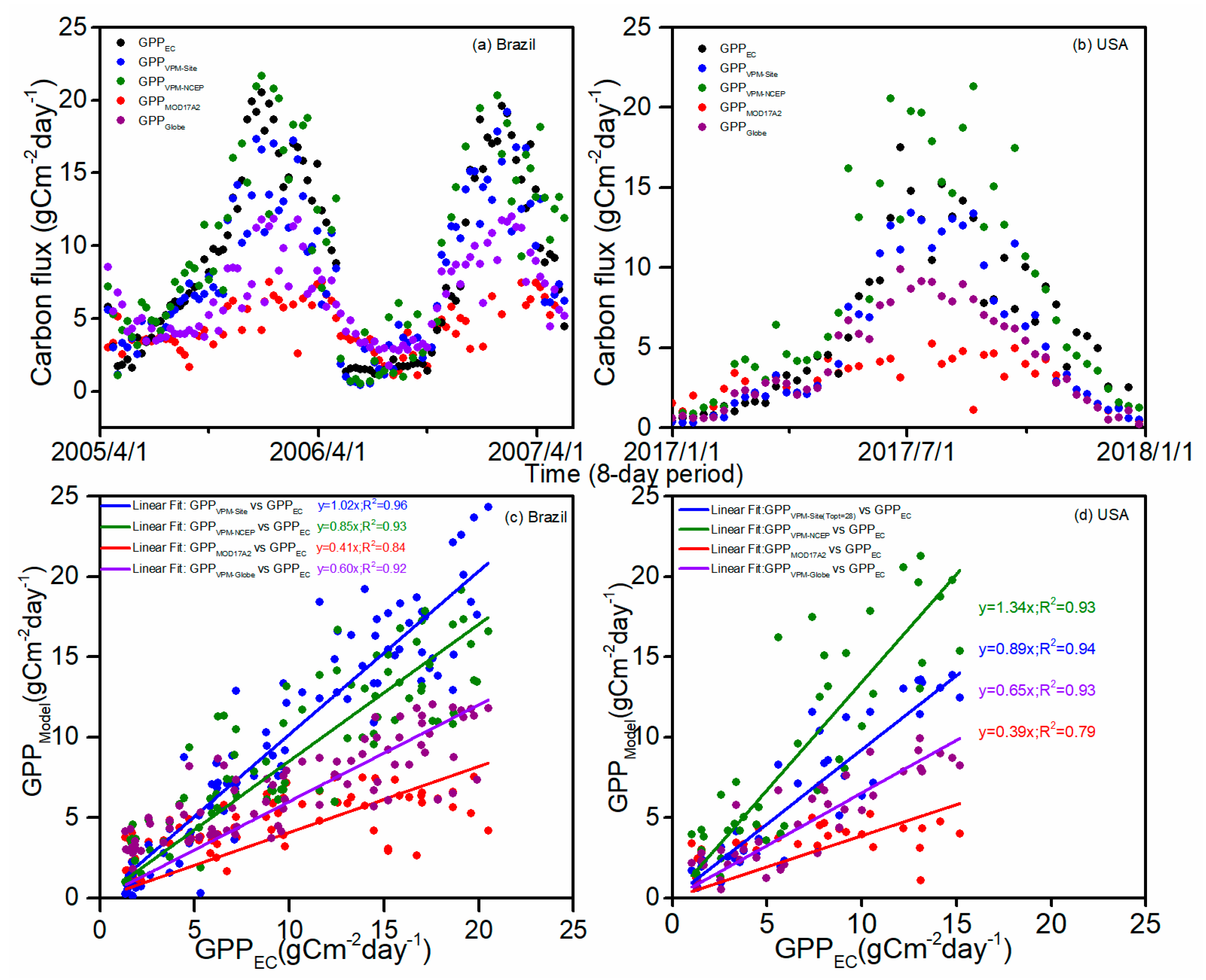
| Sites | The growing season (GPPEC≥1 g cm−2day−1) | GPPEC (g cm−2 yr−1) | GPPVPM-Site (g cm−2yr−1) | GPP%RE |
| Brazil Site | 2005/5/25–2006/5/17 | 4035.60 | 3968.45 | −1.67 |
| 2006/9/30–2007/5/17 | 2841.62 | 2868.59 | 0.95 | |
| USA Site | 2017/2/10–2017/12/11 a | 2200.88 | 1979.47 | −10.06 |
| 2017/2/10–2017/12/11 b | 2200.88 | 1976.89 | −10.17 | |
| Sites | The growing season (LSWI≥0) | GPPEC (g cm−2yr−1) | GPPVPM-Site (g cm−2yr−1) | GPP%RE |
| Brazil Site | 2005/6/18–2006/5/1 | 3873.65 | 3913.04 | 1.01 |
| 2006/9/30–2007/5/17 | 2656.27 | 2776.70 | 4.53 | |
| USA Site | 2017/5/17–2017/11/25 a | 1893.16 | 1699.05 | −10.25 |
| 2017/5/17–2017/11/25 b | 1893.16 | 1709.79 | −9.68 |
© 2020 by the authors. Licensee MDPI, Basel, Switzerland. This article is an open access article distributed under the terms and conditions of the Creative Commons Attribution (CC BY) license (http://creativecommons.org/licenses/by/4.0/).
Share and Cite
Xin, F.; Xiao, X.; Cabral, O.M.R.; White, P.M., Jr.; Guo, H.; Ma, J.; Li, B.; Zhao, B. Understanding the Land Surface Phenology and Gross Primary Production of Sugarcane Plantations by Eddy Flux Measurements, MODIS Images, and Data-Driven Models. Remote Sens. 2020, 12, 2186. https://doi.org/10.3390/rs12142186
Xin F, Xiao X, Cabral OMR, White PM Jr., Guo H, Ma J, Li B, Zhao B. Understanding the Land Surface Phenology and Gross Primary Production of Sugarcane Plantations by Eddy Flux Measurements, MODIS Images, and Data-Driven Models. Remote Sensing. 2020; 12(14):2186. https://doi.org/10.3390/rs12142186
Chicago/Turabian StyleXin, Fengfei, Xiangming Xiao, Osvaldo M.R. Cabral, Paul M. White, Jr., Haiqiang Guo, Jun Ma, Bo Li, and Bin Zhao. 2020. "Understanding the Land Surface Phenology and Gross Primary Production of Sugarcane Plantations by Eddy Flux Measurements, MODIS Images, and Data-Driven Models" Remote Sensing 12, no. 14: 2186. https://doi.org/10.3390/rs12142186
APA StyleXin, F., Xiao, X., Cabral, O. M. R., White, P. M., Jr., Guo, H., Ma, J., Li, B., & Zhao, B. (2020). Understanding the Land Surface Phenology and Gross Primary Production of Sugarcane Plantations by Eddy Flux Measurements, MODIS Images, and Data-Driven Models. Remote Sensing, 12(14), 2186. https://doi.org/10.3390/rs12142186









